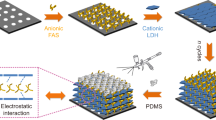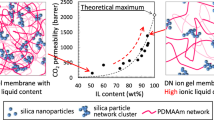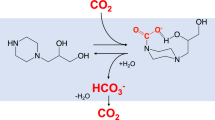Abstract
1-Aminopyridinium iodide (iodine salt) was used in CO2 separation composites consisting of CdO and 1-butyl-3-methylimidazolium tetrafluoroborate (BMIM+BF4−). Using iodine salt, the separation performance was largely improved. The CO2/N2 selectivity was 64.6 and the permeance of CO2 gas was 22.6 GPU, which was about twice that of BMIM+BF4−/CdO composites without addition of iodine salt. These results were due to the both effect of iodine salt on the transport of the N2 molecules by the cyclic ring compound and the promoting transport of CO2 molecules by the amine groups. Moreover, the oxide layer on the surface of the CdO could enhance the CO2 solubility, resulting in the enhancement of separation performance. The mechanical and chemical properties were measured using SEM, Raman, TGA and FT-IR. The cross-section of coated membranes was confirmed by SEM. The coordinative interactions of iodine salts with BMIM+BF4−/CdO composite were observed by Raman.
Similar content being viewed by others
Introduction
Most of the natural gas produced worldwide includes carbon dioxide. Carbon dioxide in nature gas occupies 70% of the total volume of gas1.
Unfortunately, carbon dioxide could cause corrosion of pipe lines in purification process and reduce the efficiency of natural gas1,2. Thus, separating and removing carbon dioxide from natural gas streams and flue gases have been major concern recently, since it could prevent pipeline corrosion and reduce global warming effects3,4,5,6. There were conventional carbon dioxide separation technologies to have been commonly used, such as carbon capture and storage (CCS) technology, solid adsorbent, adsorption and stripping using aqueous amine as liquid7,8,9. However, these existing technologies were economically costly and have the disadvantage of operating on a large scale10. On the other hand, for the case of membrane technology, it complements these disadvantages since it has many advantages such as being economically efficient, small scale operation, and being environmentally friendly11,12,13.
Polymer-based membranes, especially with ether group in their chains, have contributed to strong coordination between CO and oxygen atoms of the polymer14,15,16,17. This strong coordination could enhance solubility of CO2 molecules, resulting in the enhancement of CO2/airy gas selectivity18. For example, Liu et al. arranged poly(ether block amide)/polysulfone (PEBA/Psf) composite hollow fiber membrane. That membrane achieved a CO2 permeability up to 260 Barrer (1 Barrer = 7.5 × 10−15m3 (STP)) m/m2s K Pa) and 40–51.5 selectivity of CO2/N219. However, since poly(ethylene oxide) (PEO) has a relatively large number of ether group, its mechanical properties were relatively weak even though it has high crystallinity.
For ionic liquid (IL)-based membranes, it has various advantages such as thermally stable and had long- term stability under pressurized conditions. Using these advantages, many researches on various gas separation membranes based on ILs have been reported20,21,22. For example, membrane consisting of 1-hexyl-3-methylimidazolium nitrate (HmimNO3)/Cu nanoparticles (CuNPs) showed a selectivity of 6.2 for CO2/CH4 and 7.4 for CO2/N2 selectivity23.
In our previous study, we have studied the CO2 permeance and CO2/N2 selectivity by preparing membranes by adding various metal oxides to ionic liquids. For example, for the BMIMBF4/ZnO composite membrane, the CO2 permeance was 101 GPU and the CO2/N2 selectivity was 42.124. The ZnO oxide layer has a strong affinity for CO2 and has been shown to influence the increase in solubility of CO2. The BMIMBF4/CdO composite membrane had CO2/N2 selectivity of 32.5 and a CO2 permeance of 57.1 GPU25. As a result, when the metal oxide was introduced, the oxide layer could improve the CO2 solubility, which has influenced the CO2 transport by free ions in the ionic liquid.
In this study, BMIM+BF4−/CdO composite membrane was used with an iodine salt containing amine group in metal oxide doped membrane. For these membranes, it was expected that the amine group in iodine salt will interact with CO2 molecules for solubility enhancement. Furthermore, the CdO nanoparticles have strong affinity for CO2 capable of enhancing the transport. It was also thought that the synergistic influence of the cyclic ring effect in iodine salt plays a role as barriers for N2 transport, resulting in the increase of CO2/N2 selectivity.
Results and Discussion
SEM images analysis
As shown in Fig. 1, the morphology was examined by SEM and used to investigate the average thickness of the coating solution on the polysulfone microporous support. The average pore size of neat polysulfone was 0.1 μm and pore of surface state was also observed as microporous structure. SEM image showed that the polysulfone support was similar to the sponge like structure and the thickness of selective layer was about 8.7 μm.
Previous studies have shown that the CO2/N2 selectivity in the 1/0.007 in the composite membrane of BMIM+BF4−/CdO on polymer support with finger-like structure was 32.525. In this study, the shape of the cross-section of the polysulfone support was sponge like structure.
TEM images analysis
To investigate the CdO nanoparticles in BMIM+BF4−/CdO/iodine salt composite, TEM was observed as shown in Fig. 2. TEM image showed that the average size of generated CdO nanoparticles were ranged from 100 to 200 nm and the aggregation phenomena was observed.
Separation performance
Figure 3 showed the separation of CO2/N2 using a BMIM+BF4− ionic liquid containing CdO particles and iodine salt. The weight ratio of BMIM+BF4−/CdO was fixed at 1:0.007 and membranes with increasing mole ratio of iodine salt were tested at room temperature using a single gas (CO2 and N2). These experiments were tested three times and the single gas permeances measured for CO2 and N2 were described in Fig. 3(a). As the mole ratio of iodine salt increased, the permeance of CO2 increased to 0.05 mole ratio of salts and decreased above that ratio due to the aggregation phenomena of iodine in composite. These aggregation phenomena of iodine salts prevented the gas molecules from being transported through membrane, diminishing the permeance. Thus, CO2 permeance decreased with increasing iodine salt to 0.05 mole ratio of salts. Thus, the best separation performance was observed at 0.05 mole ratio of iodine salts as shown in Fig. 3(b).
The single gas permeance and selectivity of the composite membranes: 1/0.007 BMIM+BF4−/CdO and 1/0.007/0.05 BMIM+BF4−/CdO/iodine salt membranes were compared as shown in Table 1. Table 1 indicated that BMIM+BF4−/CdO composite membranes showed the CO2 permeance of 22.9 GPU and the selectivity of 17.6 (CO2/N2) while the CO2 permeance of 22.6 GPU and the selectivity of 64.6 for BMIM+BF4−/CdO/iodine salt composite membranes. These results were attributable to that the iodine salt acts as a hindrance to the moving of gas molecules, resulting in the decrease in overall permeance (‘barrier effect’). However, the transport of CO2 could be accelerated by the amine group of iodine salt. In addition, the interaction between the oxide layer formed from the dissociated CdO nanoparticles and the CO2 molecule also could improve the solubility of CO2.
Raman analysis
Raman was measured to investigate the interaction of iodine salt molecule in BMIM+BF4−/CdO composite. The Raman spectrum BMIM+BF4−/CdO (1/0.007) was described in Fig. 4(a), and the addition of 0.05 mol of iodine salt was shown in Fig. 4(b). The three different ionic species for various BF4− states such as ionic aggregates, ion pairs, and free ions were observed at 777, 770, and 765 cm−1, respectively26. Table 2 compared the deconvolutions of BMIM+BF4−/CdO (1/0.007) and BMIM+BF4−/CdO/iodine salt (1/0.007/0.05) for each area of BF4− species. In the case of BMIM+BF4−/CdO/iodine salt, the region of free ions was extended from 35% to 45.7%. These results suggested that new binding of BMIM + and iodine salt of BMIM+BF4−/CdO weakened the interaction between BMIM + and BF4−, leading to the increase in free ions of BF4−.
TGA analysis
The TGA of Fig. 5 was measured at room temperature up to 600 °C. In particular, the thermal stability of the BMIM+BF4−/CdO composite and BMIM+BF4−/CdO/iodine salt composites was compared using a TGA analysis. In the case of BMIM+BF4−/CdO composite, the weight loss occurred at 390 ~ 530 °C while BMIM+BF4−/CdO/iodine salt composite lost the weight at 200 ~ 500 °C. The overall graph showed that when CdO and iodine salt were added, the stability of BMIM+BF4− was gradually reduced. When CdO was added, the CdO particles were well dispersed in BMIM+BF4−, resulting in that the interactions between BMIM+BF4− and CdO generated the decrease of thermal stability25. Furthermore, the addition of iodine salt caused the iodine salt to be interacted with BMIM+BF4−, further reducing thermal stability.
FT-IR analysis
Figure 6 showed the FT-IR spectra for the neat BMIM+BF4− and BMIM+BF4−/CdO/iodine salt composites. The C-H stretching band the alkyl group of neat BMIM+BF4− was known to be observed at 2966 cm −1 27. However, when iodine salt was added to neat BMIM+BF4−, it shifted from 2966 to 2962 cm−1, due to the new coordinative interaction.
As shown in Fig. 7, with the new combination of BMIM+ and iodine salt, the existing C-H stretching band was weakened. This also indicated BF4− became more free ions when iodine salt was added to BMIM+BF4−/CdO in the raman spectra.
Conclusions
We have succeeded in preparing high selective carbon dioxide membranes consisting of BMIM+BF4−/CdO/iodine salt composite to facilitate the CO2 transport for high separation performance. The features and interactions in BMIM+BF4−/CdO/iodine salt composites were characterized by SEM, Raman, TGA, and FT-IR. The separation performance of BMIM+BF4−/CdO/iodine salt composite membrane was significantly increased compared to BMIM+BF4−/CdO composite. When CdO and iodine salt were incorporated into BMIM+BF4−, the CO2/N2 selectivity was 64.6 and the permeance of CO2 molecules was 22.6 GPU. These results were due to the both effect of iodine salt on the transport of the N2 molecules by the cyclic ring compound and the facilitating transport of CO2 molecules through the amine group.
Methods
Materials
Cadmium oxide (CdO) was supplied from Sigma-Aldrich Chemical Co. 1-Aminopyridinium iodide (Iodine salt, 97%) was supplied from Sigma-Aldrich Chemical Co. 1-Butyl-3-methyl imidazolium tetrafluoroborate (BMIM+BF4−) was supplied from Merck KGaA (Darmstadt, Germany). Ethyl alcohol (≥94.0%) was supplied from Daejung Chemicals & Metals. The microporous polysulfone support (average pore size = 0.1 μm) for the enhancement of mechanical property was provided by Toray Chemical Inc., Korea. All the chemicals were used without purification.
Preparation of membranes
The membranes were prepared utilizing BMIM+BF4−, cadmium oxide, iodine salt and ethanol. As first step, the cadmium oxide was sonicated to be dispersed in ethanol for 5 minutes. Then, BMIM+BF4− and iodine salt were added to the ethanol mixture with cadmium oxide dispersed. The solution was heated at 85 °C for 24 hours to evaporate the ethanol. Then, solution was coated onto a polysulfone microporous support and cast using a RK control coater (Model K202, Control Coater RK Print-Coat Instruments Ltd., UK). The best performance of BMIM+BF4−/CdO/iodine salt was observed at 1/0.007/0.05 (The ratio of BMIM+BF4−/CdO was described by weight ratio while BMIM+BF4−/iodine salt was mole ratio).
Gas separation experiments
The all gas flow rates represented by gas permeance were determined using a bubble flow meter at the steady-state. Gas flow rates were measured with a mass flow meter at an upstream with various pressure of psig and atmospheric downstream pressure. The permeances of CO2 and N2 were measured in gas permeance units (GPU), where 1 GPU = 1 × 106 cm3 (STP)/(cm2·s·cmHg) and the ideal selectivity was defined as CO2 permeance divided by N2 permeance.
Characterization
The scanning electron microscope (SEM; JSM – 5600 LV, JEOL) characterized prepared membranes. The transmission electron microscope (TEM; Tecnai F20 G2–200 KV, FEI) was used to characterize the CdO nanoparticle ranges in composite. The weight loss was collected using a thermogravimetric analysis (TGA; Q50 TA Instrument) of the composite membrane in flowing N2. Raman spectra of for BMIM+BF4−/CdO solution and BMIM+BF4−/CdO/iodine salt solution were obtained using a BRUKER RAM II instrument at a resolution of 4 cm−1 at room temperature. The IR measurements were used on a VERTEX 70 FT-IR spectrometer; 16–32 scans were done at a resolution of 8 cm−1. A sonifier were used Branson 450 (Branson Ultrasonics Corporation, Danbury CT, USA) with a standard tip.
References
Keller, M. Problems of epidemiology in alcohol problems. J. Stud. Alcohol 36, 1442–1451 (1975).
Assink, R. Fouling mechanism of separator membranes for the iron/chromium redox battery, J. mem. Science 17, 205–217 (1984).
Lee, D., Ryu, H.-J., Shun, D., Bae, D.-H. & Baek, J.-I. Effect of solid residence time on CO2 selectivity in a semi-continuous chemical looping combustor. Korean J. Chem. Eng. 35, 1257–1262 (2018).
Wang, Y. et al. Adsorption of carbon dioxide and water vapor on fly-ash based ETS-10. Korean J. Chem. Eng. 35, 1642–1649 (2018).
Rodenas, T. et al. Metal–organic framework nanosheets in polymer composite materials for gas separation. Nature Mater 14, 48–55 (2015).
Ramezani, R., Mazinani, S. & Di Felice, R. Potential of different additives to improve performance of potassium carbonate for CO2 absorption. Korean J. Chem. Eng. 35, 2065–2077 (2018).
Sevill, M., Ferrero, G. A. & Fuertes, A. B. Beyond KOH activation for the synthesis of superactivated carbons from hydrochar. Carbon 114, 50–58 (2017).
Singh, G., Kim, I. Y., Lakhi, K. S., Srivastava, P., Naidu, R. & Vinu, A. Single step synthesis of activated bio-carbons with a high surface area and their excellent CO2 adsorption capacity. Carbon 116, 448–455 (2017).
Kumar, S. & Mondal, M. K. Equilibrium solubility of CO2 in aqueous binary mixture of 2-(diethylamine)ethanol and 1, 6-hexamethyldiamine. Korean J. Chem. Eng. 35, 1335–1340 (2018).
Du, N., Park, H. B., Dal-Cin, M. M. & Guiver, M. D. Advances in high permeability polymeric membrane materials for CO2 separations. Energy Environ. Sci. 5, 7306–7322 (2012).
Zhao, C. et al. Hybrid membranes of metal–organic molecule nanocages for aromatic/aliphatic hydrocarbon separation by pervaporation. Chem. Commun. 50, 13921–13923 (2014).
Trinh, T. T., van Erp, T. S., Bedeaux, D., Kjelstrup, S. & Grande, C. A. A procedure to find thermodynamic equilibrium constants for CO2 and CH 4 adsorption on activated carbon. Phys. Chem. Chem. Phys. 17, 8223–8230 (2015).
Liu, H.-X., Wang, N., Zhao, C., Ji, S. & Li, J.-R. Membrane materials in the pervaporation separation of aromatic/aliphatic hydrocarbon mixtures — A review. Chinese Journal of Chemical Engineering 26, 1–16 (2018).
Sánchez-Fuentes, C. et al. Interactions between the Ionic Liquid and the ZrO2 Support in Supported Ionic Liquid Membranes for CO2 Separation. Technologies 4, 32 (2016).
Babucci, M., Akçay, A., Balci, V. & Uzun, A. Thermal Stability Limits of Imidazolium Ionic Liquids Immobilized on Metal-Oxides. Langmuir 31, 9163–9176 (2015).
Steinrück, H.-P. et al. Surface Science and Model Catalysis with Ionic Liquid-Modified Materials. Adv. Mater. 23, 2571–2587 (2011).
Giel, V., Morávková, Z., Peter, J. & Trchová, M. Thermally treated polyaniline/polybenzimidazole blend membranes: Structural changes and gas transport properties. Journal of Membrane Science 537, 315–322 (2017).
Yampolskii, Y. Polymeric Gas Separation Membranes. Macromolecules 45, 3298–3311 (2012).
Liu, L., Chakma, A. & Feng, X. Preparation of hollow fiber poly(ether block amide)/polysulfone composite membranes for separation of carbon dioxide from nitrogen. Chemical Engineering Journal 105, 43–51 (2004).
Yave, W., Car, A., Funari, S. S., Nunes, S. P. & Peinemann, K.-V. CO2 -Philic Polymer Membrane with Extremely High Separation Performance. Macromolecules 43, 326–333 (2010).
Nagel, C., Günther-Schade, K., Fritsch, D., Strunskus, T. & Faupel, F. Free Volume and Transport Properties in Highly Selective Polymer Membranes. Macromolecules 35, 2071–2077 (2002).
Vaughn, J. & Koros, W. J. Effect of the Amide Bond Diamine Structure on the CO2, H2S, and CH4 Transport Properties of a Series of Novel 6FDA-Based Polyamide–Imides for Natural Gas Purification. Macromolecules 45, 7036–7049 (2012).
Lee, J. H., Chae, I. S., Song, D., Kang, Y. S. & Kang, S. W. Metallic copper incorporated ionic liquids toward maximizing CO2 separation properties. Separation and Purification Technology 112, 49–53 (2013).
Yoon, K. W., Kim, H., Kang, Y. S. & Kang, S. W. 1-Butyl-3-methylimidazolium tetrafluoroborate/zinc oxide composite membrane for high CO2 separation performance. Chemical Engineering Journal 320, 50–54 (2017).
Kim, H., Sohn, H. & Kang, S. W. CO2 Separation Membranes Consisting of Ionic Liquid/CdO Composites. j nanosci nanotechnol 18, 5817–5821 (2018).
Lee, J. H., Hong, J., Kim, J. H., Kang, Y. S. & Kang, S. W. Facilitated CO2 transport membranes utilizing positively polarized copper nanoparticles. Chem. Commun. 48, 5298 (2012).
Cha, S. et al. Structures of ionic liquid–water mixtures investigated by IR and NMR spectroscopy. Phys. Chem. Chem. Phys. 16, 9591–9601 (2014).
Acknowledgements
This study was supported by the Basic Science Research Program (2017R1D1A1B03032583) through the National Research Foundation of Korea (NRF), funded by the Ministry of Science, ICT, and Future Planning. This study was also funded by Korea Environment Industry & Technology Institute (KEITI) as “Technology Program for establishing biocide safety management”. (RE201805019).
Author information
Authors and Affiliations
Contributions
S.W.K. led the project, conducted the data analysis and reviewed the manuscript. H.Y.K. performed the experiments, collected the data and wrote the paper.
Corresponding author
Ethics declarations
Competing interests
The authors declare no competing interests.
Additional information
Publisher’s note Springer Nature remains neutral with regard to jurisdictional claims in published maps and institutional affiliations.
Rights and permissions
Open Access This article is licensed under a Creative Commons Attribution 4.0 International License, which permits use, sharing, adaptation, distribution and reproduction in any medium or format, as long as you give appropriate credit to the original author(s) and the source, provide a link to the Creative Commons license, and indicate if changes were made. The images or other third party material in this article are included in the article’s Creative Commons license, unless indicated otherwise in a credit line to the material. If material is not included in the article’s Creative Commons license and your intended use is not permitted by statutory regulation or exceeds the permitted use, you will need to obtain permission directly from the copyright holder. To view a copy of this license, visit http://creativecommons.org/licenses/by/4.0/.
About this article
Cite this article
Kim, H.Y., Kang, S.W. CO2 separation using composites consisting of 1-butyl-3-methylimidazolium tetrafluoroborate/CdO/1-aminopyridinium iodide. Sci Rep 9, 16563 (2019). https://doi.org/10.1038/s41598-019-53002-x
Received:
Accepted:
Published:
DOI: https://doi.org/10.1038/s41598-019-53002-x
Comments
By submitting a comment you agree to abide by our Terms and Community Guidelines. If you find something abusive or that does not comply with our terms or guidelines please flag it as inappropriate.










